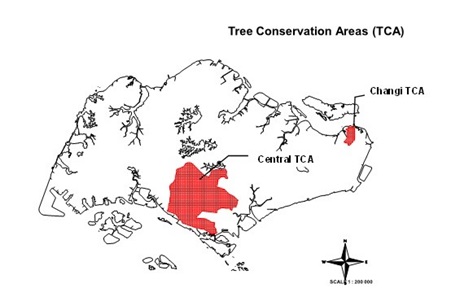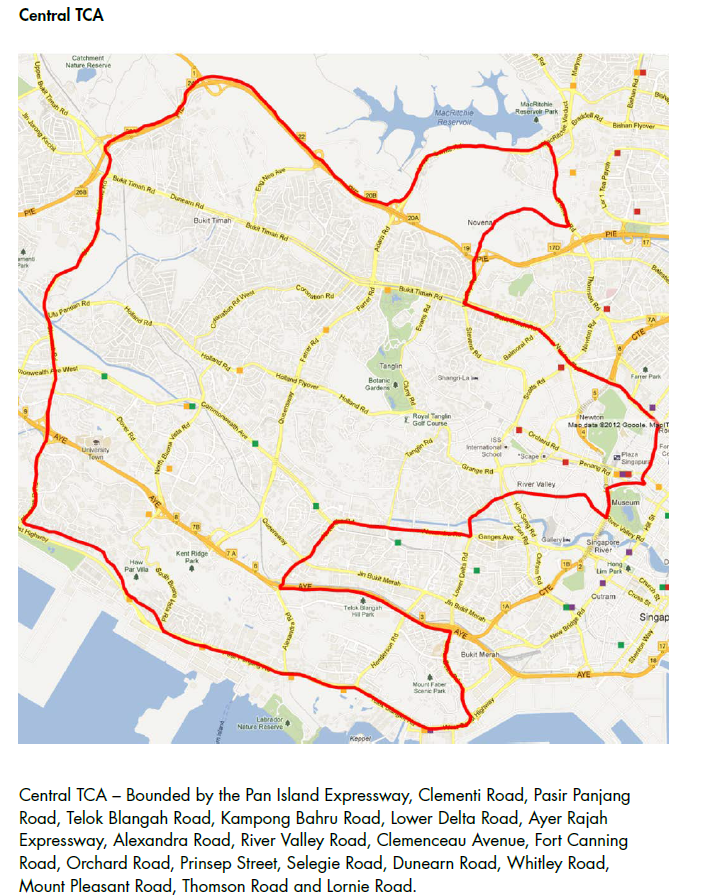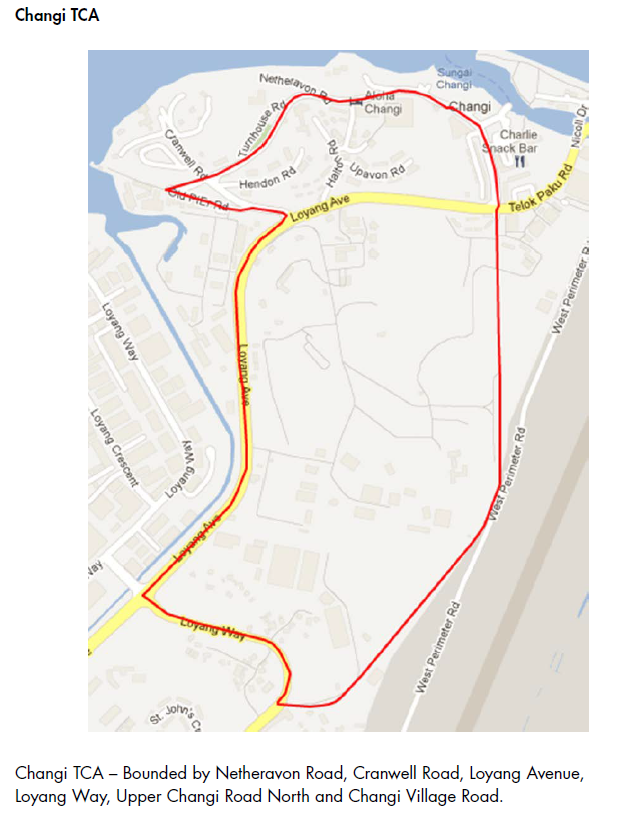Two green spaces in the South Central and Eastern parts of Singapore were gazetted as Tree Conservation Areas (TCAs) on 2 August 1991 to control indiscriminate felling of mature trees. These areas were selected for the large extent of greenery and natural heritage that are worth conserving. This vegetation, some of which are 50–100 years old, beautifies the environment with lush foliage and shaded canopies.
Developers and private property owners who wish to fell any mature tree with a girth of more than one metre have to seek written approval from the Commissioner of Parks & Recreation. This is required even if no developmental works are in progress on-site.

Central TCA (South Central of Singapore) has estimated land area of 4,700 hectares

Changi TCA (Eastern Parts of Singapore) has estimated land area of 200 hectares

To view the Tree Conservation Areas on a map, you can go to TreesSG mircosite. Access the map by clicking on "Search/Plot a Tree" and selecting the "Tree Conservation Areas" layer thereafter.
The Parks and Trees Act also contains information on the TCAs. You can read the relevant sections of the Parks and Trees Act on TCAs here.
Frequently Asked Questions about TCAs
Q1 Do the provisions for the Tree Conservation Areas under the Parks and Trees Act cover privately owned land?
Yes, the provisions apply to both State and privately owned land.
Q2 What are the types of trees protected under the TCAs?
Under the Parks and Trees Act, healthy trees with girths of more than one metre are protected as long as they provide lush greenery and improve the ambience of the TCAs.
Q3 How do you measure the girth of a tree?
Please click here for the method of measuring the girth of a tree.
Q4 What is the penalty if a tree owner proceeds to fell or remove a protected tree without attaining prior approval from NParks or complying to the stated requirements?
Under the Parks and Trees Act, if a tree owner proceeds to fell or remove a protected tree without attaining approval from NParks, the owner is liable to pay a fine not exceeding $50,000.
Q5 What is the procedure to apply for approval to remove a tree in the TCA?
To remove any tree protected in the TCA, you must submit an application to the Commissioner of Parks & Recreation, National Parks Board (NParks). Currently, NParks processes two types of such applications:
Submit your applications to:
Commissioner of Parks and Recreation
National Parks Board Headquarters
Singapore Botanic Gardens
1 Cluny Road
Singapore 259569
Telefax: 64723033
Q6 When will NParks request a report from a professional arborist?
NParks may request a report from a professional arborist when:
A professional arborist ascertains if the works have affected the health and structural integrity of the tree and assesses if the tree can be retained or needs to be removed for safety reasons.
Q7 Who is a professional arborist and what is their domain of expertise?
A professional arborist must have attained certification from the Certified Arborist Programme with the Centre for Urban Greenery and Ecology (CUGE) under NParks.
The Programme, in collaboration with the International Society of Arboriculture (ISA) based in the United States, prepares practising arborists for professional certification under the following domains:
- Tree Biology
- Soil Science
- Water Management
- Tree Nutrition and Fertilisation
- Urban Forestry
- Tree Identification
- Tree Selection
- Installation and Establishment
- Diagnosis and Plant Disorders
- Plant Health Care
- Tree Pruning
- Tree Support and Lightning Protection
- Tree Assessment and Risk Management
- Trees and Construction
- Tree Worker Safety
- Climbing and Working in Trees
This professional certification is valid for a period of three years, upon which the arborist needs to be recertified. View a list of ISA Certified Arborists.
Q8 What is the fee payable for the services of a professional arborist?
Depending on factors such as tree species size and condition, a basic visual tree assessment report by a certified arborist ranges from $150–$600 per tree.
If any additional assessment is required such as excavations, decay detection drillings and sonic tomographic measurements, the fee will be commensurated accordingly.